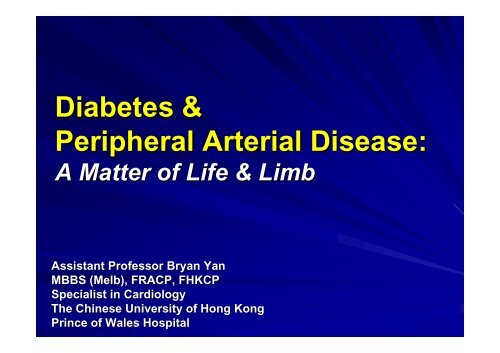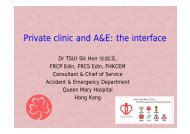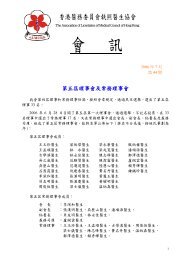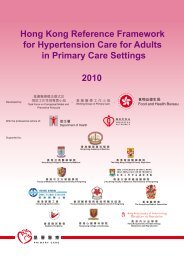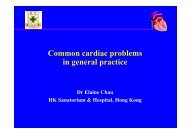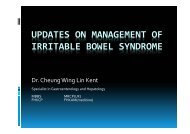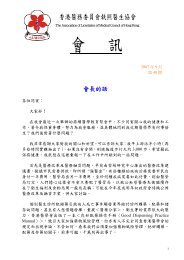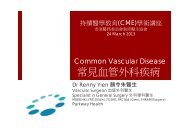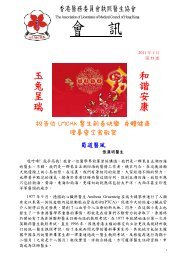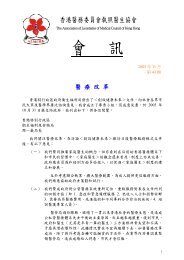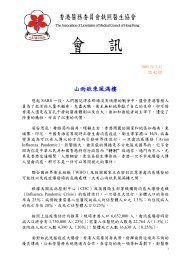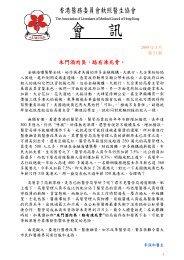Diabetes & Peripheral Arterial Disease:
Diabetes & Peripheral Arterial Disease:
Diabetes & Peripheral Arterial Disease:
You also want an ePaper? Increase the reach of your titles
YUMPU automatically turns print PDFs into web optimized ePapers that Google loves.
<strong>Diabetes</strong> &<strong>Peripheral</strong> <strong>Arterial</strong> <strong>Disease</strong>:A Matter of Life & LimbAssistant Professor Bryan YanMBBS (Melb(Melb), FRACP, FHKCPSpecialist in CardiologyThe Chinese University of Hong KongPrince of Wales Hospital
Outline1. PAD is common & prevalence is growing2. High risk of MI, stroke, amputation & death3. Impairs quality of life & physical function4. Majority are asymptomatic5. Awareness is poor6. Under-diagnosed diagnosed & under-treated7. Ankle Brachial Index Screening8. Effective treatment is available
Atherosclerosis is aSystemic <strong>Disease</strong>Cerebrovascular diseaseCoronary artery disease<strong>Peripheral</strong> arterial disease
Consequences of PAD108Increased Riskof CV events6422–3x4x6x0Stroke 1Fatal MI orCHD Death 2DeathfromCVD 21. Adapted from Kannel WB. J Cardiovasc Risk. 1994;1:333-3392. Adapted from Criqui MH, et al. N Engl J Med. 1992;326:381-386
PAD : Survival Curve1.000.75NormalSurvival0.500.250.000 2 4 6 8 10 12Time (years)AsymptomaticSymptomaticSevere symptomaticPatients with PAD on average die 10 years earlier
Relative 5-Year 5Mortality Rates1008680Patients %604020151828380BreastCancer*Hodgkin's<strong>Disease</strong>*PAD**Colon andRectalCancer*LungCancer** American Cancer Society. Cancer Facts and Figures. 1997.** Kempczinski, RF, Bernhard VM. IN: Rutherford RB, ed. Vascular Surgery. Philadelphia, PA:WB Saunders; 1989: chap 53.
Impact on Quality of Life↓ Walking distance & speed– Peak exercise ~50% of age-matched controls– Equivalent to moderate-severe heart failure patientsGradual decline if symptoms are ignored↓ Quality of life: Leisure & work activitiesAm J Cardiol 2001; 87 (suppl): 14D-18D18DAm J Med 2002; 112: 49-57
Prevalence Increases with Age60Rotterdam Study (ABI
Common Risk Factors for PAD*◄Lesser RiskGreater Risk ►<strong>Diabetes</strong>4.05SmokingHypertensionTotal cholesterol1.511.102.55Every %↑HbA1c28% risk↑* PAD diagnosis based on ABI
The Worldwide Epidemic:<strong>Diabetes</strong> TrendsMillions with <strong>Diabetes</strong>400350300250Hong Kong: ~14% aged >65 have DM200150100500301351772213003701985 1995 2000 2010 2025 2030Sources: www.who.intwww.idfZimmet P. et al Nature: 414, 13 Dec 2001
Prevalence of PAD in DMPAD is 20x more common in DM10% - 20% DM at diagnosis30% DM ≥ age 50 years40% - 60% DM with foot ulcerLower limb amputation is 15x morecommon in DMDiabet Med. 2005;22:1310<strong>Diabetes</strong> Care. 2003;26:3333
Diabetic Foot Risk1. Neuropathy2. Foot deformity &decreased sensation3. Foot injury / ulcer4. Poor blood supplyprevent healing5. Compromised defenseto infection6. Infected ulcer7. Spreading infection &gangrene
Tragic “Rule of 15”15% DM15% foot ulcers15% foot ulcersFoot ulcer in lifetimeOsteomyelitisAmputationClinical Care of the Diabetic Foot, , 2005
Tragic “Rule of 50”50% amputationsBKA / AKA50% patients50% patients2 ndnd amputation≤ 5 yearsDie in ≤ 5 yearsClinical Care of the Diabetic Foot, , 2005
Problem with PAD isUnderdiagnosed & UndertreatedAwareness LowAsymptomaticAtypical Symptoms“It is just old age”
Poor Public Awareness of PADRandom Phone Survey >6,000 in U.S.High blood pressure90High cholesterol<strong>Diabetes</strong>StrokeCoronary artery disease67777485Congestive heart failureMultiple sclerosis 4267Motor Neuron <strong>Disease</strong>Cystic fibrosis 29PAD 26360 20 40 60 80 100Gaps in Public Knowledge of <strong>Peripheral</strong> <strong>Arterial</strong> <strong>Disease</strong>: The FirstNational PAD Public Awareness Survey. Circulation 2007;116Percentage very or somewhat familiar
Clinical Presentations of PADClassic (Typical)ClaudicationAsymptomatic50%15%~33%AtypicalLeg Pain(functionally limited)1%-2%CriticalLimb Ischemia
Intermittent Claudication:“Angina of the legs”Reproducible walking induced discomfort inthe lower limb which is relieved withinminutes by stopping or standing stillPain, cramping, tightness, tiredness orachingCalf, thigh, buttockOlin JW. www.svmb.org/medpro/cme/p1/cme_part1.html 2000
Critical Limb Ischaemia (CLI)Chronic ischemic rest pain– Pain is worse at night– Relieved by dependency of the limb due to an increasein perfusion pressureNon-healing wounds & gangrene
Classification of Severity
Relying on classic history ofclaudication alone can miss 85-90%ofdiagnosis 31/3 of patients do not report symptoms 1Do not associate claudication with arterial disease& increased mortalityDo not know symptoms & signs of PADVague description….fatigue, aching, numbnessAttribute to muscular pain, arthritis, or the non-specific musculoskeletal symptoms of aging 1,2Masked by inactivity1. Dormandy et al. J Vasc Surg. 2000; 31 (supp 1, pt 2): S1-S2962. Olin JW. www.svmb.org/medpro/cme/p1/cme_part1.html 20003. Hirsch et al. JAMA. 2001; 286: 1317-1324
Differential DiagnosisCALFVenous occlusion– Tight bursting pain / dullache that worsens onstanding and resolves withleg elevation– Positional pain reliefChronic compartmentsyndrome– Tight bursting pain– Positional pain reliefNerve root compression– Positional pain reliefBaker’s s cyst– Positional pain reliefHIP/THIGH/BUTTOCKArthritis– Persistent pain, brought on byvariable amounts of exercise– Associated symptoms in otherjointsSpinal cord compression– History of back pain– Symptoms while standing– Positional pain reliefFOOTArthritisBuerger disease(thromboangitis obliterans)Am J Cardiol 2001; 87 (suppl): 3D-13D
• Colour• Deformities• Ulcer• Skin break• Infection• PulsesPhysical ExaminationAbsent pedal pulses predicts severe PADAbsence of a single pedal pulse does not predict PADPresence of pedal pulses does not rule out PAD!
High Clinical Suspicion of PAD1. Elderly2. Smokers3. Diabetics4. Patients with known CV disease5. Claudication6. Rest pain with elevation7. Non-healing ulcers8. Diminished distal pulses
Are you at risk for <strong>Peripheral</strong> <strong>Arterial</strong> <strong>Disease</strong> (PAD)?DO YOU HAVE:Cardiovascular (heart) problems such ashigh blood pressure, heart attack, stroke?<strong>Diabetes</strong>A family history of diabetes or cardiovascular problems?(immediate family such as parent, sister, brother)Aching, cramping or pain in your legs when you walk orexercise, but then the pain goes away when you rest?Pain in your toes or feet at night?Any ulcers or sores on your feet or legs that are slow in healing?An inactive lifestyle?Do you smoke?Have you ever smoked?Yes NoYes NoYes NoYes NoYes NoYes NoYes NoYes NoYes No
Diagnostic Critical PathwayClinical Evaluation:History and PhysicalABI AvailableABI Not AvailablePADDiagnosisReferral to Vascular Lab• Assessment of location/severity is desired• ABI >1.3• Normal ABI but PADsuspicion is highVascular Lab Evaluation• Segmental pressures• Pulse volume recordings• TreadmillPADDiagnosisAdapted from American <strong>Diabetes</strong> Association. <strong>Diabetes</strong> Care. 2003;26:3333-3341.
Ankle Brachial Index (ABI)ABI =Lower extremity systolic pressureBrachial artery systolic pressureScreening: At risk of PADDiagnosis: Claudication, absent pulses, foot ulcerLimitations: Underestimates severity in calcified arteries
Using the ABI: An ExampleRight ABI80/160=0.50Left ABI120/160=0.75ABI(Normal >0.90)Brachial SBP140 mm HgBrachial SBP160 mm HgHighestbrachial SBPPT SBP 40 mm HgDP SBP 80 mm HgPT SBP 120 mm HgDP SBP 80 mm HgHighest of PTor DP SBPABI=ankle-brachial index; DP=dorsalis pedis; PT=posterior tibial; SBP=systolic blood pressure.
Interpretation of the ABIInterpretationABINormal 1.0-1.301.30Borderline 0.9-1.0Mild 0.7-0.890.89Moderate* 0.4-0.690.69Severe* 1.302˚ to calcification in elderly, DM, renal failure*Poor ulcer healing with ABI < 0.50**Further vascular evaluation needed
ABI:Highly Sensitive & SpecificEffectiveness of ABI vs. Other CommonScreening TestsDiagnostic Test Sensitivity (%) Specificity (%)ABI 1,2,3 95 99Pap smear 4 30-87 86-100Fecal occult blood test 5 37-78 87-98Mammography 6 75-90 90-961. Newman AB, et al. Arterioscler Thromb Vasc Biol. 1999;19:538-545; 2. Dormandy JA, et al. SeminVasc Surg. 1999;12:96-108; 3. Fowkes FG, et al. Int J Epidemiol. 1991;20:384-392; 4. Nanda K, et al.Ann Intern Med. 2000;132:810-819; 5. Allison JE, et al. N Engl J Med. 1996;334:155-159;6. Ferrini R, et al. Am J Prev Med. 1996;12:340-341.
Who should be screened with ABI?1. All patients who have exertional legsymptoms [B]2. All patients between the age of 50-69 & whohave a cardiovascular risk factor(particularly diabetes or smoking) [B]3. All patients age >70 years regardless of riskfactor status [B].4. All patients with a Framingham risk score10%-20% [C].TASC II Inter-Society Consensus on <strong>Peripheral</strong> <strong>Arterial</strong> <strong>Disease</strong>, 2007
Other Non-invasivetests for PADSegmental limbpressure with pulsevolume recordingDuplex Ultrasound
MRA & CTAPlanning forrevascularizationBPGlocation & severity ofstenosisMRACTA>50% stenosisOcclusionSensitivity84%79%85%Specificity97%89%98%
PAD ManagementDiagnosisPatient Management StrategiesRisk Reductionof IschaemicEventsControl of risk factors—Smoking— Hyperlipidaemia— Hypertension— <strong>Diabetes</strong>Antiplatelet therapyTreatment ofSymptomsExercisePharmacologictherapy— CilostazolRevascularization forselected patients
PAD Treatment GoalsImproveFunctionalStatus &QOLPreventLimbLossPreventProgression ofAtherosclerosisReduceCardiovascularEvents &Mortality
Physician Awareness lower than MI & StrokeUnderestimate CV riskOverestimate amputation riskWelten, G. M.J.M. et al. J Am Coll Cardiol 2008;51:1588-1596
Conservative TreatmentA- anti-plateletB- blood pressure control (BP
Exercise Program30-45 min3 x / weekMin 12 weeksUp to 180%↑walkingdistance
Cilostazol (Pletaal)AntiplateletactivityAntithromboticactivityVasodilationCilostazolIncreasesblood flowIn vitro inhibitionof vascularsmooth musclecellsDecreasestriglyceridesIncreasesHDL-C
Cilostazol (Pletaal)ACC/AHA 2005 guidelines
Prevention of Amputation in DMRegular foot screeningEarly detection of footlesionEarly vascular evaluationSpreading foot infectionin DM with PAD ismedical emergency– Do not delay forconservative treatment– Early intervention isoften the onlyopportunity to savethe limb & life
Indication forRevascularization1. Threatened limb– Rest pain– Non-healing ulcer– Gangrene2. Significant lifestylelimitation– Severe claudication– Failed medical therapy
60M, smoker, DM, lipid, CAD, CVA,bilateral claudication @30mABI : R 0.65 L 0.51
Traditional Aorto-bifemoralBypass?
Surgical Morbidity & MortalityWound Infection 10 - 30%Myocardial Infarction 1.9 - 3.4%Acute leg ischemia 1.0 - 2.0%Early graft failure 0 - 24%Mortality 1.3 - 6.0%Surgical Revision rate > 20%TASC J Vasc Surg 2000
Kissing Iliac Stenting
Advantages of EndovascularTreatmentLocal anesthesiaLower morbidityLower complication ratesHigh surgical risk patientsQuicker recoveryLess acute failure (cf. bypass graft)RepeatableNot preclude surgical optionPatient preference
ACC/AHA 2005 GuidelinesEndovascular Treatment for ClaudicationIIIa IIb IIIEndovascular procedures are indicated forindividuals with a lifestyle-limiting disability due tointermittent claudication when clinical featuressuggest a reasonable likelihood of symptomaticimprovement with endovascular intervention and…a. Response to exercise or pharmacologic therapy isinadequate, and/orb. there is a very favorable risk-benefit ratioIIIa IIb IIIEndovascular intervention is not indicated asprophylactic therapy in an asymptomatic patientwith lower extremity PAD.
Limb Salvage for CLIAvoid / Limit amputation– Lowest level…………foot & ankle– Improve chance of ambulationRevascularization– “Straight Line Flow” to pedal arch“Tide-over” concept– After wound healed, tissue integritymay remain even if vessel re-occludes– Re-intervention often not necessaryDedicated wound care program
452 patients with critical limb ischemiaMean follow up: 5.5 yearsAmputation-Free SurvivalAll-Cause MortalityLancet 2005;366:1925-1934
Changing pattern ofrevascularization for CLI+460%J Vasc Surg 2006;44:304-13
Trends in endovascular interventions,major amputation, and lower extremitybypass surgery
74M, DM, Smoker, 1mth infected footgangrene, ABI 0.25, refuses surgery
TP TrunkPerforationATPeroneal
Ray amputation same admissionMeticulous podiatry careAugustOctoberJanuaryWalk 100m with single prong stick
Meta-analysis:analysis:Patency & Limb Salvage
NO!
SFA: Longest Vessel in the BodyWorst1.Extension / Contraction2.TorsionCompression3.Flexion 4.Sitting/Stair climbing90/90 degreesKnee/hip flexion
SFA Compressive Forces: StentFractureStent fracture16cm 52.0.0%
Infrainguinal Intervention
“Fracture Resistant” SE Stents15cm
….catheter-based interventions are currentlyperformed by individuals with formal trainingin interventional radiology, interventionalcardiology & vascular surgeryAll bring particular strengths….
Which Patients to Refer?Difficult Diagnosis– High-risk patients with atypical symptoms /normal ABISevere Claudication– Not respond to medical therapyLimb SalvageRest painUlcerInfectionGangrene
SummaryPAD is common, often asymptomatic & under-diagnosedPAD associated with increased CV mortality &functional impairmentABI is simple & accurate non-invasive test for PADAggressive risk factor modification & antiplatelettherapy essentialEndovascular therapy provides less invasive optionto surgery for many patients
Key RoleTake Home Massage:Role of General Physicians in theManagement of PADEarly detection of asymptomatic / atypical disease inhigh-risk patients (e.g. DM)ABI screening (diagnosis & prognosis)Initiate risk reduction therapy (A to H)Patient EducationEarly referral for critical limb ischemia
Public & Physician Awareness of<strong>Peripheral</strong> <strong>Arterial</strong> <strong>Disease</strong> in HongKong:A cross-sectional sectional SurveyPrincipal Investigator: Bryan YanSurvey Objectives• Obtain baseline data to quantify public knowledge of thecauses (risk factors), symptoms, and ischemic risks - tolife and limb - of PAD• Results intended to serve as a benchmark so thatimprovements in awareness can be documented over time• To direct public education programs to raise PADawareness
Save a Leg . . . Save a LifeThank You


